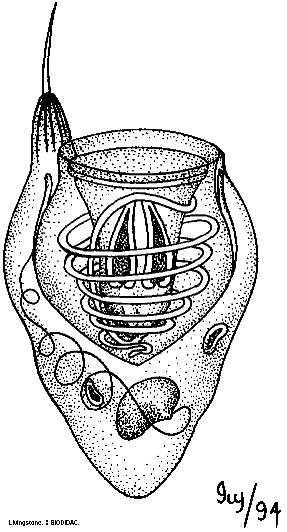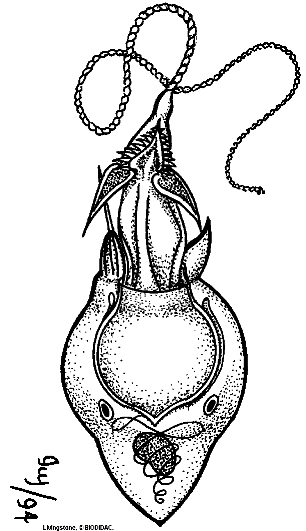Nutrition
This Australian box jellyfish is an intense predator to organisms in its habitat. They hunt so successfully due to their tentacles that stretch up to 3 meters behind their bell. These tentacle are in groups of 15 on each corner of the "box" of the mature jellyfish. This means that each of these individual box jellies have the capacity of capturing prey with 60 tentacles! Each of these tentacles house millions of cells called cnidocytes. These are stinging cells that make this species so deadly. The picture below (left) is demonstrating the structure of a cnidocyte that hasn't been discharged into a prey item yet. The picture below (right) is demonstrating the structure of the cnidocyte once it has been released into the prey.
Cnidocytes are the main structure used by these
jellyfish while on the hunt for a meal. Each of these
cnidocytes houses a special structure called a
nematocyst. Millions of these structures line the
tentacles of the box jellyfish, making them so dangerous
to come across. The nematocyst is in the shape of a
harpoon (indicated by the red arrow below), ready to release and fire into any prey item
the jellyfish comes across. Sensitive hairs line the
tentacles and are detecting vibrations near these
tentacles. When prey swims by, the nematocyst fires and
ejects its deadly venom into the organism. This
process is shown in the figure to the right. Once one of
these cells fire, all the cells around it fire too,
releasing more venom into the prey. These prey items
usually include small fish, shrimp, and crustaceans.
This deadly sequence is what this jellyfish uses to eat.
Once their prey item is paralyzed by their venom, the
tentacles slowly move them near the opening of the body
cavity. This opening is the only route into, and out of, the body of
the jellyfish. This opening allows the jelly to take in
nutrients and excrete wastes.
red arrow below), ready to release and fire into any prey item
the jellyfish comes across. Sensitive hairs line the
tentacles and are detecting vibrations near these
tentacles. When prey swims by, the nematocyst fires and
ejects its deadly venom into the organism. This
process is shown in the figure to the right. Once one of
these cells fire, all the cells around it fire too,
releasing more venom into the prey. These prey items
usually include small fish, shrimp, and crustaceans.
This deadly sequence is what this jellyfish uses to eat.
Once their prey item is paralyzed by their venom, the
tentacles slowly move them near the opening of the body
cavity. This opening is the only route into, and out of, the body of
the jellyfish. This opening allows the jelly to take in
nutrients and excrete wastes.
Once inside the mouth, the prey is now digested extracellularly in the organism's gastrovascular cavity, also called a coelenteron. This is a cavity that is convoluted to maximize nutrient uptake from their meal. This cavity absorbs nutrients through its gastrodermal lining until it's completely broken down. Once this occurs, the nutrients are distributed to the rest of the body through the radial canals. These canals are like tubes that lead nutrients from the coelenteron to the rest of the body, mainly the tentacles. Running down the length of these tentacles assures that all the cells in its body will get the nourishment needed to function and keep the jellyfish alive.
Now that you know how this species obtains its food, continue to the Reproduction page to learn how it creates new jellyfish.
Are you lost? Start over by visiting the Home page!


